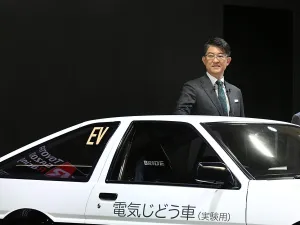This week, Toyota announced that it will develop smaller, “carbon-neutral” internal combustion engines that can take biofuels, e-fuels and hydrogen to support its hybrid vehicles—rather than offering more battery electric vehicles—in yet another delay in the auto giant’s move toward a fully electric future. Toyota said it will partner with Japanese automakers Mazda and Subaru to push the idea that these smaller combustion engines and biofuels, e-fuels and hydrogen are the interim path toward a carbon-neutral future, as part of the company’s “multi-pathway” approach on the road to zero emission.
Sign Up For Our Daily Newsletter
SIGN UP
It’s not exactly a popular method, at least with climate change groups that have been publicly calling for Toyota to ramp up its EV commitment for years. “The EV transition is moving ahead and threatens to leave Toyota behind if, at every opportunity, the global automaker digs its heels into cars with internal combustion engines, or ICEs, instead of investing in electrification.” Katherine García, director of Sierra Club Clean Transportation for All, an environmental group, wrote a statement emailed to Observer in response to Toyota’s announcement.
In truth, Toyota has long lagged behind other automakers, including Volkswagen and Tesla (TSLA), when it comes to offering a suite of battery EVs, and there are plenty of questions about just how “carbon-neutral” biofuels, e-fuels and hydrogen are. “Alternative fuels are still a little bit further out, and I think there are some questions around how you generate them and when you create something else that takes more water and electricity to generate and create. It doesn’t necessarily solve the problem,” Stephanie Brinley, a principal automotive analyst at S&P Global Mobility, told Observer.
Toyota long dominated the hybrid space with this innovative and fuel-efficient Prius. It has also offered the Toyota Mirai, a hydrogen vehicle, for many years. Today, the company is leaning hard into hybrid and PHEV (plug-in hybrid electric vehicles) powertrains and played a significant role in lobbying against stricter EPA regulations that rolled out in March.
Toyota currently only offers two battery EVs across its Lexus and Toyota brands; the strangely named Toyota bZ4x and the Lexus RZ. As of recent earnings, the company only sold a measly 1,897 bZ4x vehicles and 1,603 Lexus RZ models in the U.S. during the first quarter. Together, the two represent just 0.6 percent of Toyota’s total sales.
While current battery technology is far from carbon-neutral thanks to its heavy reliance on lithium and other highly pollutant rare earth minerals (most of which are mined in countries that rely on slave labor to extract them), battery electric transportation puts out zero emissions on the road. Similarly, e-fuels and biofuels are also resource-intensive to create, yet output less or close to zero emissions on the road. ICEs, like those in gasoline and diesel-powered vehicles, put out a significant amount of pollutive emissions every day, and the oil and gas industry isn’t exactly known for its environmental friendliness.
At the same time, as Brinley points out, we shouldn’t ignore the possibility that alternative fuels and electrified powertrains (hybrid, PHEV) might be a solid first step along the road to electrification–especially when it comes to how Americans use their vehicles. She said the U.S. consumer isn’t fully ready to embrace electric vehicles, thanks to charging infrastructure issues, high vehicle cost and range anxiety, and points out that Toyota, under the new leadership of CEO Koji Sato, sees that.
“I don’t think that Toyota is saying that hybrid is the end and that it’s not electric vehicles,” Brinley said. “It’s a matter of when and how you get there. That long, 15 to 20 years to get to a state where you’re all electric or all hydrogen means you’ve got a lot of space and a lot of opportunity for internal combustion engines to support electrification systems. I think they’ve been very clear in their actions, that what they’re looking at as an internal combustion engine will support electrification.”


